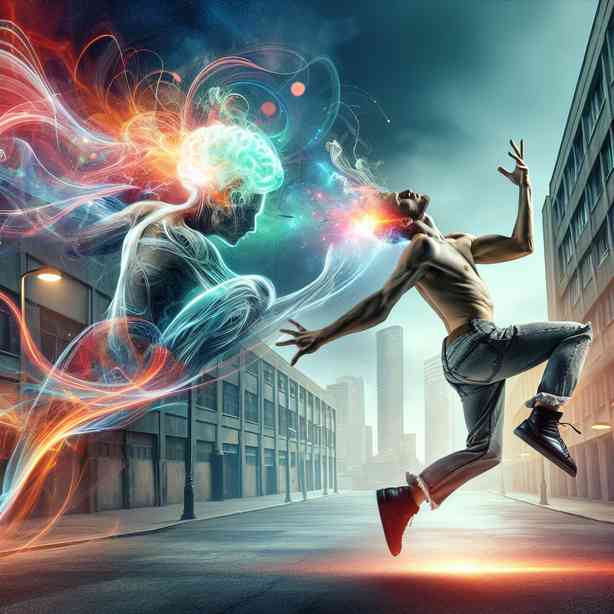
When your body freestyles before your brain, it highlights the fascinating interplay between our physical movements and cognitive processes. This phenomenon, often observed during spontaneous dance or physical activities, illustrates how our bodies can express emotions or ideas even before our conscious mind has fully processed them.
This concept invites us to explore how our bodies can serve as a medium for expression, sometimes even overriding the constraints of our rational thoughts. The capacity for movement to convey feelings is not merely a human experience; it’s a universal language, transcending words, cultures, and backgrounds.
Our bodies are equipped with a sophisticated system of signals and cues that often operate independently of our thoughts. This is particularly evident in modes of expression like dance, where the body can respond to music or rhythm instinctively. When a catchy tune plays, for example, you might find yourself tapping your foot or swaying your hips without a second thought. This visceral reaction demonstrates that the body can act in ways that our brain might still be processing, creating a unique synchrony of movement and cognition.
Dance movements can be viewed as an intricate form of communication, where every twirl and step tells a story. The rhythms of music can evoke memories or feelings that inspire our bodies to move in ways that may seem automatic. As such, we can consider dance not just a recreational activity but also a therapeutic one. Engaging in such expressive movement can facilitate emotional release, boost mood, and even foster social connections.
Furthermore, neuroscience offers intricate insights into this phenomenon. Research has shown that physical movement triggers the release of neurotransmitters such as dopamine and serotonin, which play crucial roles in enhancing mood and promoting feelings of happiness. This biological response exists alongside our cognitive processes, outlining a dual engagement; when your body pulse to the beat, it not only displays a spontaneous reaction but also a profound physical and psychological response.
Moreover, various cultural practices also reflect this relationship between body and mind. Traditional dances often emerge as communal activities, providing individuals a way to connect with others deeply, even before words are exchanged. Such cultural expressions are rooted in a shared history, drawing people together and fostering a sense of belonging through collective movement.
Incorporating mindfulness into movement offers another dimension to this connection. Mindful movement practices, such as yoga or tai chi, emphasize being present in one’s body, allowing individuals to tune into sensations and feelings that they might typically overlook. This practice enhances the interplay between cognitive awareness and physical expression, enabling a deeper connection with one’s self and surroundings.
There is also a realm of exploration in competitive dance environments, where individuals are pushed to synchronize their actions with not only the music but with their partners and the audience. This competitive aspect adds layers to the experience, bridging instinctual bodily responses with strategic cognitive planning. Dancers must read cues from their environment, anticipate movements from their partners, and make swift decisions—all while performing their routines. This complex interaction showcases the remarkable capability of our bodies to respond with precision and elegance.
Physical fitness activities also provide a similar backdrop for where the body takes charge, leading the brain to follow. When engaged in sports or workouts, sometimes our muscles act before our mind has the chance to fully comprehend what’s happening. This often results in a state of flow, a phenomenon where individuals are so absorbed in their activity that they lose track of time and self-consciousness. In such states, one’s bodily instincts can take the lead, allowing for peak performance and creative expression.
This concept extends into the realm of rehabilitation as well. Numerous therapies utilize movement as a therapeutic tool to help individuals recover from physical impairments. Patients can often find themselves moving in ways that feel natural and intuitive, sometimes before they consciously remember the instructions. This highlights the body-brain connection, particularly how ingrained movements can emerge even in the face of cognitive difficulties.
The relationship between the body and brain allows for a unique exploration of identity and self-expression. The way one moves can tell a story about experiences, emotions, and social connections without the reliance on language. Each movement carries weight and meaning, often reflecting one’s inner thoughts, feelings, and states of being.
In the world today, especially with advancing technology and modern lifestyles, there is a growing emphasis on the need to reconnect with our bodies. Amidst rapid changes, prioritizing movement fosters a balance between our physical and cognitive selves. Exploring activities that encourage self-expression through movement can significantly enhance one’s quality of life through increased joy, fulfillment, and community connection.
To summarize, the phenomenon of your body freestyling before your brain is a beautiful testament to the deep interplay between physical expression, emotional release, and cognitive understanding. It serves as a reminder that our bodies are not merely vessels of our thoughts but active participants in shaping our experiences, emotions, and interactions with the world around us. By exploring this connection, we can uncover new ways to express ourselves, foster community, and embrace the joyful spontaneity of life, reminding us that sometimes, the best movements emerge from within, independent of our conscious deliberation.


